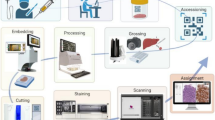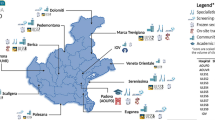Abstract
Although digital pathology is a relatively new entity, the digital pathology products have become a mature product. This maturity is evidenced by the approval from the Food Drug and Administration to market digital pathology systems for primary diagnosis. The recent COVID-19 pandemic crisis has highlighted the value that digital pathology can provide to the practice of pathology. There are many potential use cases that may justify a department’s efforts to adopt digital pathology. Besides these well-established use cases for digital pathology, newer sophisticated tools are being developed to aid the pathologist and to deliver a more complex and detailed report for patient care. In this manuscript, I will attempt to review the aspects of these use cases with associated efficiencies and expenses in order to inform a pathology department about how adoption of digital pathology may fit within their long-term strategy. Finding the right fit for your department will allow your department to draw the maximal benefit from this powerful technology.
Access this chapter
Tax calculation will be finalised at checkout
Purchases are for personal use only
Similar content being viewed by others
References
Murphy RL Jr, Bird KT. Telediagnosis: a new community health resource. Observations on the feasibility of telediagnosis based on 1000 patient transactions. Am J Public Health. 1974;64(2):113–9.
Pantanowitz L, et al. Experience with multimodality telepathology at the University of Pittsburgh Medical Center. J Pathol Inform. 2012;3:45.
Kaplan KJ, et al. Use of robotic telepathology for frozen-section diagnosis: a retrospective trial of a telepathology system for intraoperative consultation. Mod Pathol. 2002;15(11):1197–204.
Weinstein RS, et al. Overview of telepathology, virtual microscopy, and whole slide imaging: prospects for the future. Hum Pathol. 2009;40(8):1057–69.
Ghosh A, Brown GT, Fontelo P. Telepathology at the Armed Forces Institute of Pathology: a retrospective review of consultations from 1996 to 1997. Arch Pathol Lab Med. 2018;142(2):248–52.
Farahani N, Pantanowitz L. Overview of telepathology. Surg Pathol Clin. 2015;8(2):223–31.
Dietz RL, et al. Review of the use of telepathology for intraoperative consultation. Expert Rev Med Devices. 2018;15(12):883–90.
Ekong D, et al. Evaluation of android smartphones for telepathology. J Pathol Inform. 2017;8:16.
Dietz RL, Hartman DJ, Pantanowitz L. Systematic review of the use of telepathology during intraoperative consultation. Am J Clin Pathol. 2020;153(2):198–209.
Collins BT. Telepathology in cytopathology: challenges and opportunities. Acta Cytol. 2013;57(3):221–32.
Khurana KK. Telecytology and its evolving role in cytopathology. Diagn Cytopathol. 2012;40(6):498–502.
Archondakis S, et al. Telecytology: a tool for quality assessment and improvement in the evaluation of thyroid fine-needle aspiration specimens. Telemed J E Health. 2009;15(7):713–7.
Monaco SE, et al. Assessing competency for remote telecytology rapid on-site evaluation using pre-recorded dynamic video streaming. Cytopathology. 2019;31:411.
Monaco SE, et al. Telecytology implementation: deployment of telecytology for rapid on-site evaluations at an Academic Medical Center. Diagn Cytopathol. 2019;47(3):206–13.
Heher YK, et al. Achieving high reliability in histology: an improvement series to reduce errors. Am J Clin Pathol. 2016;146(5):554–60.
Huisman A, et al. Creation of a fully digital pathology slide archive by high-volume tissue slide scanning. Hum Pathol. 2010;41(5):751–7.
Finn WG. Diagnostic pathology and laboratory medicine in the age of "omics": a paper from the 2006 William Beaumont Hospital Symposium on Molecular Pathology. J Mol Diagn. 2007;9(4):431–6.
Gutman DA, et al. The digital slide archive: a software platform for management, integration, and analysis of histology for cancer research. Cancer Res. 2017;77(21):e75–8.
Pantanowitz L, et al. Twenty years of digital pathology: an overview of the road travelled, what is on the horizon, and the emergence of vendor-neutral archives. J Pathol Inform. 2018;9:40.
Marques Godinho T, et al. An efficient architecture to support digital pathology in standard medical imaging repositories. J Biomed Inform. 2017;71:190–7.
Evans AJ, et al. US Food and Drug Administration approval of whole slide imaging for primary diagnosis: a key milestone is reached and new questions are raised. Arch Pathol Lab Med. 2018;142(11):1383–7.
Mills AM, et al. Diagnostic efficiency in digital pathology: a comparison of optical versus digital assessment in 510 surgical pathology cases. Am J Surg Pathol. 2018;42(1):53–9.
Jen KY, et al. Reliability of whole slide images as a diagnostic modality for renal allograft biopsies. Hum Pathol. 2013;44(5):888–94.
Kent MN, et al. Diagnostic accuracy of virtual pathology vs traditional microscopy in a large dermatopathology study. JAMA Dermatol. 2017;153(12):1285–91.
Glatz-Krieger K, et al. Factors to keep in mind when introducing virtual microscopy. Virchows Arch. 2006;448(3):248–55.
Hanna MG, et al. Comparison of glass slides and various digital-slide modalities for cytopathology screening and interpretation. Cancer Cytopathol. 2017;125(9):701–9.
Sarewitz SJ. Subspecialization in community pathology practice. Arch Pathol Lab Med. 2014;138(7):871–2.
Huber AR, et al. Accuracy of vascular invasion reporting in hepatocellular carcinoma before and after implementation of subspecialty surgical pathology sign-out. Indian J Pathol Microbiol. 2017;60(4):501–4.
Iezzoni JC, et al. Selective pathology fellowships: diverse, innovative, and valuable subspecialty training. Arch Pathol Lab Med. 2014;138(4):518–25.
Sharma M, et al. Effects of subspecialty signout and group consensus on the diagnosis of microscopic colitis. Virchows Arch. 2019;475(5):573–8.
Leong AS, Braye S, Bhagwandeen B. Diagnostic 'errors' in anatomical pathology: relevance to Australian laboratories. Pathology. 2006;38(6):490–7.
Manion E, Cohen MB, Weydert J. Mandatory second opinion in surgical pathology referral material: clinical consequences of major disagreements. Am J Surg Pathol. 2008;32(5):732–7.
Strosberg C, et al. Second opinion reviews for cancer diagnoses in anatomic pathology: a comprehensive cancer center's experience. Anticancer Res. 2018;38(5):2989–94.
Satta G, Edmonstone J. Consolidation of pathology services in England: have savings been achieved? BMC Health Serv Res. 2018;18(1):862.
Gu J, Taylor CR. Practicing pathology in the era of big data and personalized medicine. Appl Immunohistochem Mol Morphol. 2014;22(1):1–9.
Wood JP. Legal issues for pathologists. Adv Anat Pathol. 2011;18(6):466–72.
Martin SA, Styer PE. Assessing performance, productivity, and staffing needs in pathology groups: observations from the College of American Pathologists PathFocus pathology practice activity and staffing program. Arch Pathol Lab Med. 2006;130(9):1263–8.
Johnson P. Branding an anatomic pathology practice to build revenue. Clin Leadersh Manag Rev. 2004;18(4):220–5.
Chorneyko K, et al. Canada's pathology. CMAJ. 2008;178(12):1523–6.
Digital Pathology Association Survey for Digital Pathology. May 22, 2020]; Available from: https://vr2.verticalresponse.com/emails/46179488376453?contact_id=46179491246273&sk=aXYQB2JgqjBIJQGhRANUF5NkdMNR7i4qbu1NmWr7QH9g=/aHR0cHM6Ly92cjIudmVydGljYWxyZXNwb25zZS5jb20vZW1haWxzLzQ2MTc5NDg4Mzc2NDUzP2NvbnRhY3RfaWQ9NDYxNzk0OTEyNDYyNzM=/3088BgyqSse7WoOHcuEdmw==.
Pantanowitz L, et al. Validating whole slide imaging for diagnostic purposes in pathology: guideline from the College of American Pathologists Pathology and Laboratory Quality Center. Arch Pathol Lab Med. 2013;137(12):1710–22.
Hanna MG, et al. Whole slide imaging equivalency and efficiency study: experience at a large academic center. Mod Pathol. 2019;32(7):916–28.
Vrekoussis T, et al. Image analysis of breast cancer immunohistochemistry-stained sections using ImageJ: an RGB-based model. Anticancer Res. 2009;29(12):4995–8.
Laurinavicius A, et al. Immunohistochemistry profiles of breast ductal carcinoma: factor analysis of digital image analysis data. Diagn Pathol. 2012;7:27.
Mofidi R, et al. Objective measurement of breast cancer oestrogen receptor status through digital image analysis. Eur J Surg Oncol. 2003;29(1):20–4.
Lopez C, et al. Digital image analysis in breast cancer: an example of an automated methodology and the effects of image compression. Stud Health Technol Inform. 2012;179:155–71.
Brugmann A, et al. Digital image analysis of membrane connectivity is a robust measure of HER2 immunostains. Breast Cancer Res Treat. 2012;132(1):41–9.
Koopman T, et al. What is the added value of digital image analysis of HER2 immunohistochemistry in breast cancer in clinical practice? A study with multiple platforms. Histopathology. 2019;74(6):917–24.
Bankhead P, et al. Integrated tumor identification and automated scoring minimizes pathologist involvement and provides new insights to key biomarkers in breast cancer. Lab Investig. 2018;98(1):15–26.
Aeffner F, et al. Introduction to digital image analysis in whole-slide imaging: a white paper from the digital pathology association. J Pathol Inform. 2019;10:9.
Theodosiou Z, et al. Evaluation of FISH image analysis system on assessing HER2 amplification in breast carcinoma cases. Breast. 2008;17(1):80–4.
Hartman DJ, et al. Utility of CD8 score by automated quantitative image analysis in head and neck squamous cell carcinoma. Oral Oncol. 2018;86:278–87.
Hartman DJ, et al. Automated quantitation of CD8-positive T cells predicts prognosis in colonic adenocarcinoma with mucinous, signet ring cell, or medullary differentiation independent of mismatch repair protein status. Am J Surg Pathol. 2020;44:991.
Monaco SE, et al. Quantitative image analysis for CD8 score in lung small biopsies and cytology cell-blocks. Cytopathology. 2020;31:393.
Galon J, Fridman WH, Pages F. The adaptive immunologic microenvironment in colorectal cancer: a novel perspective. Cancer Res. 2007;67(5):1883–6.
Pages F, et al. Immune infiltration in human tumors: a prognostic factor that should not be ignored. Oncogene. 2010;29(8):1093–102.
Galon J, et al. Type, density, and location of immune cells within human colorectal tumors predict clinical outcome. Science. 2006;313(5795):1960–4.
Klebanoff CA, Gattinoni L, Restifo NP. CD8+ T-cell memory in tumor immunology and immunotherapy. Immunol Rev. 2006;211:214–24.
Indar A, et al. Current concepts in immunotherapy for the treatment of colorectal cancer. J R Coll Surg Edinb. 2002;47(2):458–74.
Taube JM, et al. Implications of the tumor immune microenvironment for staging and therapeutics. Mod Pathol. 2018;31(2):214–34.
Schalper KA, et al. Objective measurement and clinical significance of TILs in non-small cell lung cancer. J Natl Cancer Inst. 2015;107(3):dju435.
Jackson SR, Yuan J, Teague RM. Targeting CD8+ T-cell tolerance for cancer immunotherapy. Immunotherapy. 2014;6(7):833–52.
Yeo MK, et al. Clinical usefulness of the free web-based image analysis application ImmunoRatio for assessment of Ki-67 labelling index in breast cancer. J Clin Pathol. 2017;70(8):715–9.
Niazi MKK, Parwani AV, Gurcan MN. Digital pathology and artificial intelligence. Lancet Oncol. 2019;20(5):e253–61.
FDA permits marketing of artificial intelligence-based device to detect certain diabetes-related eye problems. October 22, 2019]; Available from: https://www.fda.gov/newsevents/newsroom/pressannouncements/ucm604357.htm.
Hartman DJ, et al. Value of public challenges for the development of pathology deep learning algorithms. J Pathol Inform. 2020;11:7.
Litjens G, et al. 1399 H&E-stained sentinel lymph node sections of breast cancer patients: the CAMELYON dataset. Gigascience. 2018;7(6):giy065.
Choy G, et al. Current applications and future impact of machine learning in radiology. Radiology. 2018;288(2):318–28.
Dreyer KJ, Geis JR. When machines think: radiology's next frontier. Radiology. 2017;285(3):713–8.
Jara-Lazaro AR, et al. Digital pathology: exploring its applications in diagnostic surgical pathology practice. Pathology. 2010;42(6):512–8.
Romero Lauro G, et al. Digital pathology consultations-a new era in digital imaging, challenges and practical applications. J Digit Imaging. 2013;26(4):668–77.
Baidoshvili A, et al. Validation of a whole-slide image-based teleconsultation network. Histopathology. 2018;73(5):777–83.
Mosquera-Zamudio A, et al. Advantage of Z-stacking for teleconsultation between the USA and Colombia. Diagn Cytopathol. 2019;47(1):35–40.
Wilbur DC, et al. Whole-slide imaging digital pathology as a platform for teleconsultation: a pilot study using paired subspecialist correlations. Arch Pathol Lab Med. 2009;133(12):1949–53.
Nahal A, et al. Setting up an ePathology service at Cleveland Clinic Abu Dhabi: joint collaboration with Cleveland Clinic, United States. Arch Pathol Lab Med. 2018;142(10):1216–22.
Zhao C, et al. International telepathology consultation: three years of experience between the University of Pittsburgh Medical Center and KingMed Diagnostics in China. J Pathol Inform. 2015;6:63.
Humphreys H, et al. Pathology in Irish medical education. J Clin Pathol. 2020;73(1):47–50.
Dee FR. Virtual microscopy in pathology education. Hum Pathol. 2009;40(8):1112–21.
Ford J, Pambrun C. Exit competencies in pathology and laboratory medicine for graduating medical students: the Canadian approach. Hum Pathol. 2015;46(5):637–42.
Chen CP, et al. Improving medical students' understanding of pediatric diseases through an innovative and tailored web-based digital pathology program with philips pathology tutor (Formerly PathXL). J Pathol Inform. 2019;10:18.
Jajosky RP, et al. Fewer seniors from United States allopathic medical schools are filling pathology residency positions in the Main Residency Match, 2008-2017. Hum Pathol. 2018;73:26–32.
Magid MS, Cambor CL. The integration of pathology into the clinical years of undergraduate medical education: a survey and review of the literature. Hum Pathol. 2012;43(4):567–76.
Metter DM, et al. Trends in the US and Canadian pathologist workforces from 2007 to 2017. JAMA Netw Open. 2019;2(5):e194337.
Author information
Authors and Affiliations
Corresponding author
Editor information
Editors and Affiliations
Rights and permissions
Copyright information
© 2022 Springer Nature Switzerland AG
About this chapter
Cite this chapter
Hartman, D.J. (2022). Developing a Clinical Workflow That Fits Your Needs. In: Parwani, A.V. (eds) Whole Slide Imaging. Springer, Cham. https://doi.org/10.1007/978-3-030-83332-9_4
Download citation
DOI: https://doi.org/10.1007/978-3-030-83332-9_4
Published:
Publisher Name: Springer, Cham
Print ISBN: 978-3-030-83331-2
Online ISBN: 978-3-030-83332-9
eBook Packages: MedicineMedicine (R0)




